More results...
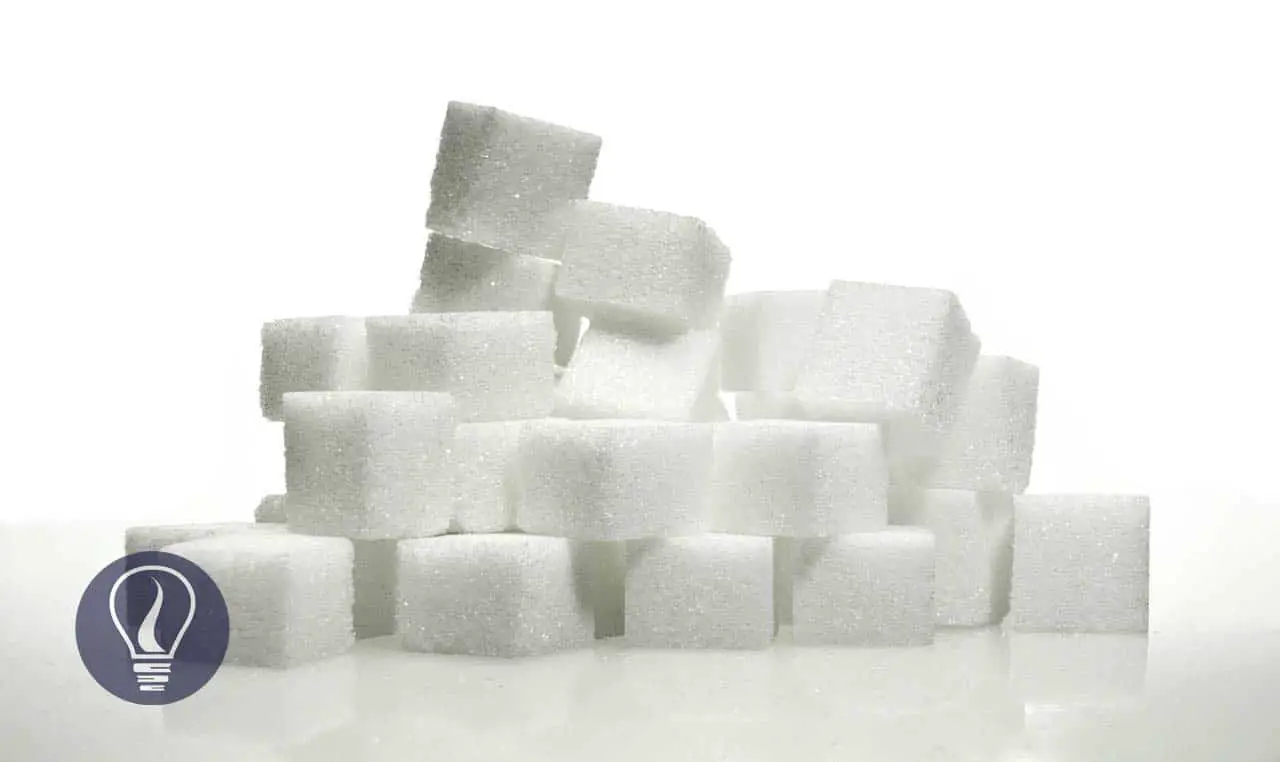

Food can be any animal and plant source. Food is a nutritional substance that is essential to maintain life, that animals consume (drink and eat), or plants absorb to maintain their life.
Food undergoes changes from ‘farm to fork’. During transportation, storage, and distribution food quality changes and it will directly affect people's health. 2 billion people do not have enough food and around 40,000 people die every day from diseases related to inadequate diets, lack of sufficient food, proteins, or specific nutrients.
Water is an essential component of all food. Water is occurring in varying amounts in the different types of food. Food is not a single component. Food components interact with each other (e.g., glucose + amino acids, lipids + water)
Major components of the food are Carbohydrates, Proteins, and Lipids. Vitamins, Minerals, Pigments, and flavor compounds are the other components of food.
Sugars, Starch, Cellulose, hemicellulose, Pectin, and gums can be classified under carbohydrates. Carbohydrates are identified as the main energy source in food. The main elements that create carbohydrate molecules are Carbon (C), Hydrogen (H), and Oxygen (O). The general molecular for the carbohydrates are:
Cx (H2O) y. In carbohydrates, hydrogen, and oxygen are in the same ratio as water.
The basic unit of carbohydrates is monosaccharides. These are the simplest carbohydrates, and these are single sugar molecules. All monosaccharides are soluble in water. These cannot be broken down further (hydrolyzed) into smaller carbohydrate units.
The number of carbon atoms present in the monosaccharide molecule is used to classify monosaccharides. And according to the -OH group, monosaccharides can be classified into two groups “The Aldose group” and the “Keto group” these aldehyde and keto groups act as reducing groups in the molecules. Therefore, those monosaccharides are known as reducing sugars.
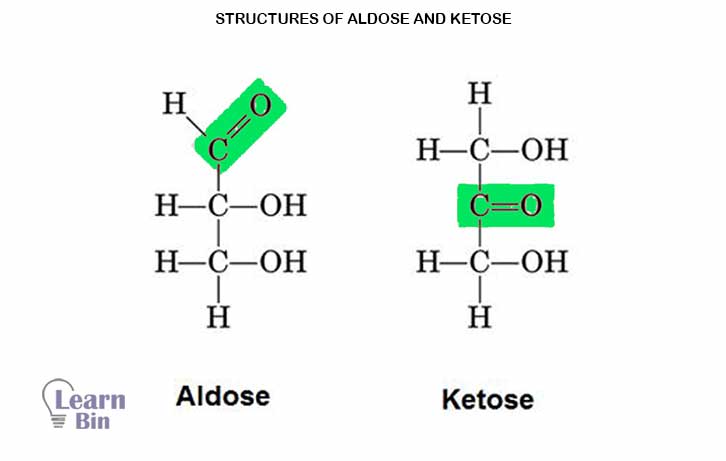
| Molecular formula | Nomenclature | Example for Aldose group | Example for Keto group |
| C3H6O3 | Triose | Glyceraldehyde | Dihydroxyacetone |
| C4H8O4 | Tetrose | Erythrose | - |
| C5H10O5 | Pentose | Ribose Deoxyribose | Ribulose |
| C6H12O6 | Hexose | Glucose Galactose | Fructose |
Disaccharides are carbohydrates that are formed by two monosaccharides that are bonded by a “Glycosidic bond”. Disaccharides can be hydrolyzed into monosaccharides which may be the same or different.
e.g., Sucrose(C12H22O11) can be hydrolyzed into glucose and fructose.
| Disaccharide | Building blocks | Occurrence in food |
| Maltose | Two glucose molecules | Ripe fruits Germinating seeds |
| Lactose | Glucose + Galactose | Breast milk |
| Sucrose | Glucose + Fructose | Sucrose is the main carbohydrate that is transported in plant phloem. |
Disaccharides can be hydrolyzed into monosaccharides by using enzymes or acids. The resulting sugars (monosaccharides) are called inverted sugars. Invert sugars are used in hard-boiled sweets. They are not really solid or liquid. But they appear solid. It has a glassy texture. Due to their low water content, inverted sugars are supercooled liquids.
Glucose syrup is an inverted sugar that is formed by the enzymatic hydrolyzation of corn starch. Alpha-amylase is used as the enzyme to hydrolyze corn starch.
Starch is hydrolyzed by using enzymes and ends up with Fructose. In HFCS, the Glucose: Fructose ratio is important in industrial applications. It should be balanced.
Sweetness can be either nutritive or non-nutritive. Natural sugars, sugar alcohols, and HFCS are examples of nutritive sweetness. Non-nutritive sweetness occurs in synthetic sugars such as Saccharin, Cyclamate, Aspartame, etc.
The reason for the sweetness of sugars is a chemical interaction happens between sugar molecules and the receptor sites of the receptor cells in our tongue. The intermolecular Hydrogen bond is formed between the receptor and sugar molecule. AH, proton to B orbital distance is approximately 3 Å.
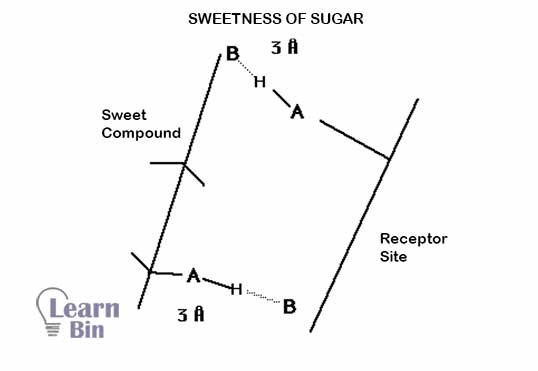
| Sugar | Relative Sweetness (on a weight basis) |
| Sucrose | 1.00 (Reference) |
| D- Fructose | 1.52 |
| Xylitol | 1.00 |
| D-Glucose | 0.76 |
| Sorbitol | 0.60 |
| Mannitol | 0.50 |
| D-Galactose | 0.50 |
| Lactose | 0.33 |
| Trehalose | 0.2 |
| Saccharin | 450 |
| Cyclamate | 40 |
| Aspartame | 200 |
Sugars (monosaccharides and disaccharides) are soluble due to the formation of H-bonds.
All monosaccharides are soluble in water. Most polysaccharides are insoluble in water.
β-D-Glucose is more soluble in water than α-D-Glucose because all OH groups are equatorial, therefore, low steric hindrance.
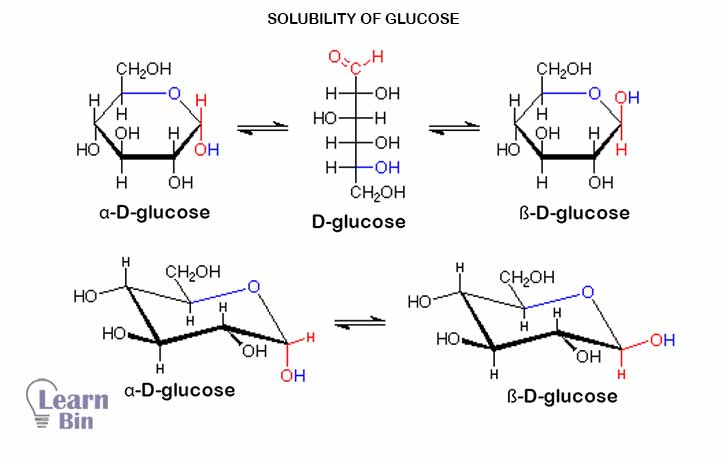
Non-reducing sugars such as Sucrose crystallizes easily. In the confectionery industry, the crystallization of sucrose must be prevented. To prevent crystallization, Glucose or inverted syrup is added. Sucrose is dissolved in inverted sugar and boiled to reduce the total water content. The final result of this process is a glass-like structure, a supercooled malleable liquid when it is hot but it becomes a glassy solid when it cools.
Browning is the process by which food turns brown due to an internal chemical reaction. Sugars undergo different types of browning reactions. One of the most important reactions of fruits and vegetables is “Enzymatic browning “. Enzymatic browning affects its taste, color, flavor, and nutritional value. This specific reaction is a result of the oxidation of phenolic compounds by polyphenol oxidase (PPO). This reaction produces dark color pigments.
Other types of browning reactions are Maillard browning, Caramelization, Lipid browning, Vitamin C browning, etc.
Millard browning is a complex series of reactions in all foods that contain carbonyl groups and free amino groups. The products of the reaction contribute colors, flavors, and odors to foods (both desirable and undesirable) Millard browning reaction may reduce the availability of essential amino acids in foods such as lysine.
To take place in the Millard browning reaction the food must have a reducing sugar and protein which provides an amino group. The product of the reaction is Melanoidin which is a brown pigment. The reaction is controlled by the number of open-chain sugars and amino groups, Time, Temperature, pH, and water activity. Browning reactions are inhibited by acids. Because amines are protonated in the presence of acids.
Steps of Millard browning reaction,
Stages:
When food-grade carbohydrate is applied to controlled heat treatment, a dark brown, amorphous product is formed which is called caramel. The caramelization reaction is not involved, in amino groups. Caramelization occurs when heating up to 160-180 ℃ in the absence of water or concentrated solutions of carbohydrates. The color is generated in varying degrees of brown and the chemical structure of the formed pigments is uncertain.
| Caramel product | Molecular formula |
| Caramelan | C24H36O18 |
| Caramelen | C38H50O25 |
| Caramelin | C125H188O80 |
The caramelization reaction is accelerated by increasing acids, alkalis, or salts and temperatures to get the desired characteristics. In some food industries, the colored compounds that are made from caramelization are collected to use as a food ingredient and used in Beer, gravies, Cola, root beer, and bakery products.
These are large molecules formed from small units of carbohydrates. Polysaccharides are high molecular weight polymers. Most polysaccharides are insoluble in water. No sweetness and no crystallization. Polysaccharides do not have any reducing properties.
Polysaccharides can be divided as follows
Starch is the main stored food in plants. The building block monosaccharide of starch is α- Glucose. Starch is a mixture of two polysaccharides, Amylose and Amylopectin.
Starch gelatinization
Gelatinization of starch is the uptake of water, loss of crystallinity and birefringence, swelling of granule, and finally the breakdown of the granule. The starch undergoes gelatinization under a given temperature which is specific to the type of starch. It is called “Gelatinization” All starches have this property and happens when processed.
In cold water, starch remains intact because of the internal H-bonding
When gelatinization of starch, changes in starch viscosity are evaluated using a Brabender amylograph. Starch slurry is heated (and cooled) at a constant rate with constant stirring and viscosity is measured.
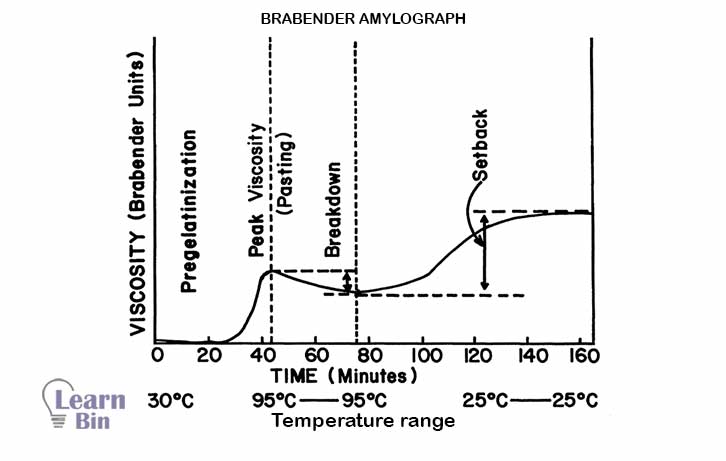
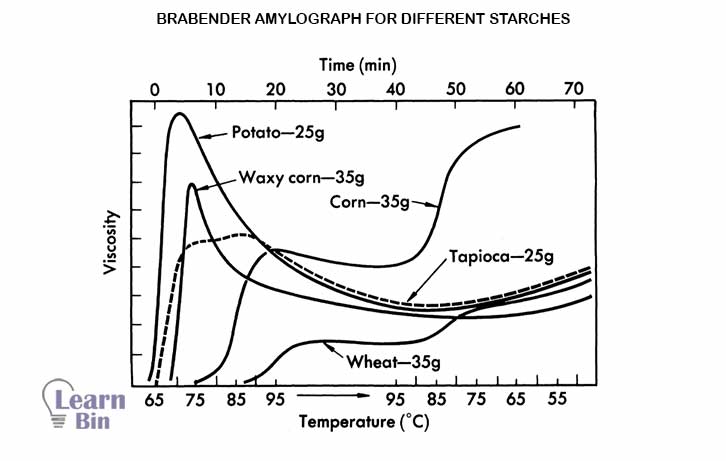
Retrogradation of starch
Retrogradation is the process of the crystallization of starch molecules after the starch granule has burst. The texture of staled bread is due in part to retrogradation. Most quality defects in starch-based food products are due to this. Bread staling and loss of viscosity, and precipitation in soups and sauces are due to Starch retrogradation.
Pectin is formed by polymerizing “Galactose” and “Galacturonic” acids. Pectin is a substance of the middle lamellae of plant cell walls. Its function is to move H2O
between cells and it acts as the cement material for the cellulose network. There is 85% of galacturonic acid in pectin. Some aldehyde groups are esterified with methyl alcohol (DE = degree of esterification)
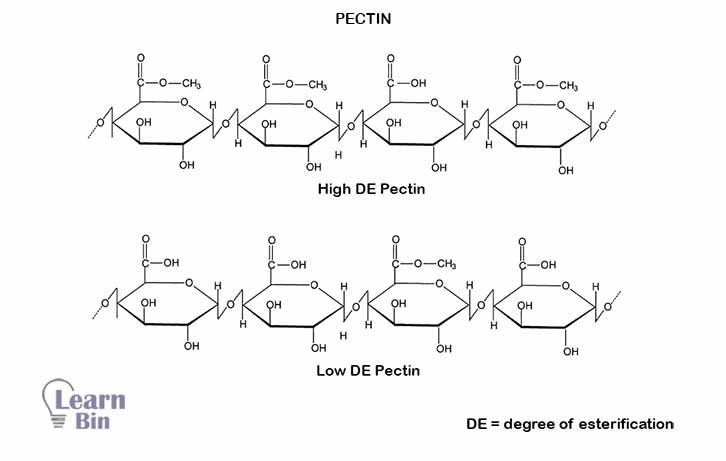
Most unmodified pectin has a DE of around 50-80%
Young, unrepented plants and fruits have very high DE and hard textures. Old, ripened plants/fruits have lower DE; so, they have a softer texture.
Pectin gels are used to manufacture Jelly and Jams in the food industry. 70% esterified Pectin is used for the rapid set and 50 -70% esterified pectin is used for the slow set.
The pectin that derives from different sources may differ in chemical and functional properties. In the food, industry pectin is important because of its ability to form the gels that can be used as the basis of jam and other fruit preserves.
The most abundant organic compound on the earth is cellulose. The main structural compound in the plant cell wall is Cellulose. It gives tensile strength to the cell wall. Cellulose is a polymer with a very high molecular weight, and it is a water-insoluble polymer of β – glucose. It forms β- 1-4 glycosidic bonds between β – glucose molecules. These bonds provide cellulose with a very strong, rigid straight parallel chain. This chain has extensive H-bonds.
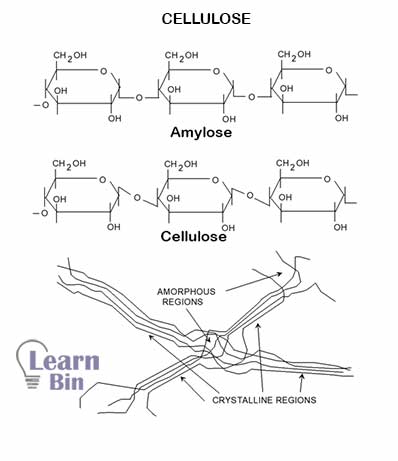
Cellulose structure has both crystalline regions and amorphous regions. Due to the very tight H-bonding, it has a very tough texture. And cellulose is insoluble in water. But there is little access to hydrolytic reagents and enzymes.
Cellulose has β-1-4 glycosidic bonds; therefore, cellulose is not digestible by humans. It is just the pass-through of the digestive system. And no contribution for calories.
Cellulose can be modified according to the need to improve its function.
Microcrystalline cellulose is prepared by partial acid hydrolysis. Non-crystalline regions of cellulose are penetrated by acid and cleaved to release the crystalline regions. Crystalline regions combine to form microcrystals. In the food industry, MCC is used to stabilize emulsions, Absorb oils & syrups.
| Colloidal MCC | Powdered MCC |
| Mechanical energy was applied after the hydrolysis process to separate microcrystals to form small micro-aggregates. Water dispersible –similar function as food gums In the food industry, powdered MCC is used as Foam and emulsion stabilizer, Pectin, starch stabilizer, Fat, and oil replacement. | These are spray-dried MCC. Forms aggregated porous/sponge-like microcrystals Use as a Flavor carrier and anti-caking agent in powders and cheese. |
First. Cellulose is treated with alkali to expand the fibers. Then methyl chloride is added. And get methyl ether group. Methylcellulose can be dissolved in cold water (water-soluble) because the Methyl ether group breaks the H-bonding that is present in cellulose. The solubility is increasing with increasing temperature. Because heating dehydrates the cellulose and hydrophobic methyl ether groups start to interact. When dissolving, viscosity increases, and methylcellulose forms a gel.

Cellulose is treated with alkali to expand fibers and then chloroacetic acid is introduced to get the carboxymethyl ether group. Carboxymethyl cellulose can be dissolved in both cold water and hot water (water-soluble).
Food uses
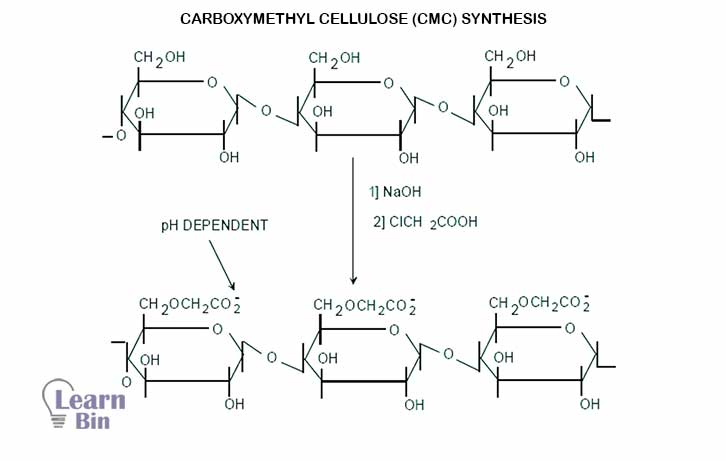
| Substance | Occurrence in food |
| Sugars | Fructose in fruits Sucrose in fruits, sugar cane, beet Lactose in milk |
| Starch | Cereals Yams Tubers |
| Pectin | Fruits and vegetables |
| Cellulose | Plant cell walls (fiber) |
| Gums | Seed and bark exudates Xanthan gums Alginates |

Cover Image by jan mesaros from Pixabay